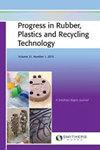从农业企业回收塑料的技术可能性
IF 1.6
4区 材料科学
Q4 MATERIALS SCIENCE, COMPOSITES
Progress in Rubber Plastics and Recycling Technology
Pub Date : 2021-06-01
DOI:10.1177/14777606211019420
引用次数: 0
摘要
厄瓜多尔农业工业部门产生的塑料废物是主要的环境影响之一,特别是在花卉和香蕉生产方面,因为它们分别被用作温室盖和水果簇的保护元素。由于暴露在环境中造成的降解程度,以及使用农药造成的污染程度,情况变得更加复杂,塑料一旦超过使用期限就会出现这种情况。目前的研究分为两个阶段:塑料废物的表征和后处理前的调理。结果显示,花卉和香蕉部门的塑料废物,其主要材料分别对应于LDPE和HDPE,呈现出污染水平,使其被视为“无害”废物,这允许它们被回收利用,但它们的过程必须由合格人员进行适当控制和执行。暴露的香蕉袋的降解水平表明,材料的拉伸力学性能损失小于50%,这意味着材料没有降解,可以直接回收。此外,样品中膜两侧的FTIR-ATR光谱没有记录有代表性的氧化带。另一方面,在温室废弃物中,抗拉强度50%以上的力学性能损失以及材料结构中明显的羰基形成表明塑料的降解。因此,回收的可行性将取决于原始材料的掺入。对废物进行调理以进行后续回收,表明需要一个由四个阶段组成的洗涤过程:初始清洗、预洗、洗涤和风干。本文章由计算机程序翻译,如有差异,请以英文原文为准。
Technical possibilities for recycling plastics from agribusiness
Plastic waste generated by the Ecuadorian agro-industrial sector represents one of the main environmental impacts, particularly in floricultural and banana production, as a result of its use as a greenhouse cover and as a protective element for the fruit cluster, respectively. The situation become more complicated because of the level of degradation caused by environmental exposure and the degree of contamination due to the use of agrochemicals that plastics present once their useful life has expired. The current research was divided into two stages: characterization of plastic waste and conditioning prior to reprocessing. The results revealed the plastic waste of the floricultural and banana sector, whose predominant material corresponds to LDPE and HDPE, respectively, presents a level of contamination that allows them to be considered as “non-hazardous” waste, which allows them to be recycled, but their processes must be properly controlled and carried out by qualified people. The level of degradation in the exposed banana bags showed losses of mechanical properties of tensile less than 50%, which means that the material is not degraded and it is feasible to recycle it directly. Additionally, the FTIR-ATR spectra on both sides of the film in the samples did not register representative bands of oxidation. On the other hand, in the greenhouse waste, the losses of mechanical properties of tensile strength above 50% as well as the noticeable formation of carbonyl groups in the structure of the material showed the degradation of the plastic. Therefore, the feasibility of recycling will depend on the incorporation of virgin material. The conditioning of the waste for subsequent recycling revealed the need of a washing process consisting of four stages: initial cleaning, pre-wash, washing, and air-drying.
求助全文
通过发布文献求助,成功后即可免费获取论文全文。
去求助
来源期刊

Progress in Rubber Plastics and Recycling Technology
MATERIALS SCIENCE, COMPOSITES-POLYMER SCIENCE
CiteScore
4.40
自引率
7.70%
发文量
18
审稿时长
>12 weeks
期刊介绍:
The journal aims to bridge the gap between research and development and the practical and commercial applications of polymers in a wide range of uses. Current developments and likely future trends are reviewed across key areas of the polymer industry, together with existing and potential opportunities for the innovative use of plastic and rubber products.
 求助内容:
求助内容: 应助结果提醒方式:
应助结果提醒方式:


